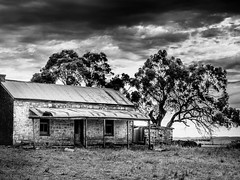The latest digital SLRs are great – high image quality, fast AF in low light, ability to use high ISO, great optical viewfinders, live preview for accurate manual focus, wide selection of lenses with remote TTL flash – there is a kit for almost every photographic need.
BUT there are a few problems with digital SLRs:
- they are big and heavy – not the type of camera to take to social events or to work every day, nor even the best for travel unless you choose the lightest, smallest ones such as Olympus E620. The harder they are to hide, the more you may become a target for assault and theft which can be a big issue whilst traveling or even just walking the streets.
- they are noisy – the inevitable clunk of the mirror going up and down makes them problematic in situations where such noises draw unwelcome attention such as wedding ceremonies, your daughter’s cello concert, etc.
- they are unlikely to be optimised for realtime AF in HD video without substantial changes to their lens mount and lens AF architecture – something Canon and Nikon are not going to want to embark upon lightly!
- despite their relentless push to ever more pixels and larger file sizes with their storage problems, the legacy lenses are not generally able to deliver the optical resolution to match the sensors resulting in little more detail than one would get from a 12mp sensor. This will require updating almost all lenses if one wants to make the most of the 20+mp sensors
- high resolution images (eg 20+mp) require more than a 20+mp sensor and excellent optical resolution – they need close attention to focus accuracy as well as avoidance of camera shake or mirror vibrations – the higher the resolution to be attained, the more precise the photographer needs to be
- the larger the image sensor, the lower the noise at high ISO and the more dynamic range, shallower depth of field but you are forced to have much bigger and heavier lenses, tripod heads and potentially worse edge-to-edge image quality as optical aberrations increase the further from the centre.
- the requirement for a reflex mirror restricts their design options substantially and adds mirror vibrations and noise as mentioned above
- their main problem is their tiny sensors which cause the following issues:
- limited dynamic range
- high image noise or low image detail at high ISO (> ISO 400)
- inability to attain shallow depth of field for nice portraits
- the lack of interchangable lenses means there is always a compromise on focal lengths available, how wide open the aperture can be, optical quality of lens, lack of capability for fun options such as lens baby or tilt shift lenses, and often inability to use filters such as polarising filters or neutral density gradient filters
- A sensor 5x the size of a Canon G10 point and shoot sensor and only marginally smaller than a Nikon D90 or Canon 50D dSLR.
- this gives you image quality comparable to dSLR image quality, and the ability to get shallow depth of field for portraiture (although not as shallow as with full frame dSLRs)
- the sensor technologies can be shared with Four Thirds dSLRs for economies of scale as they can be the same sensors
- the absence of a mirror means smaller size, more design options, no mirror vibrations to blur your image, no mirror noise to disturb the peace, and perhaps most important of all, a short sensor to lens flange distance which can make them a Universal Digital Back for almost any lens ever made and the potential to create tilt-shift adapters to have them all image stabilised tilt-shift lenses and can be used with HD video to boot! Just an incredible versatility that has been opened up because contrast-detect AF technology and image processing technology has improved sufficiently to allow these types of cameras to be produced. In a word – REVOLUTIONARY!
- they fit into a system – they can use Four Thirds flash and lenses and thus can act as a backup camera when needed, and unlike a point and shoot, your lens investment goes with you to your next Micro Four Thirds body – indeed, you may have several Micro Four Thirds bodies each with different characteristics – a HD video camera vs a Leica-like street camera vs a truly pocketable camera vs a IR modded camera, etc.
What about the point and shoot cameras – they are small, light and silent?
Now you should be able to see where the Micro Four Thirds comes into the picture!
Already we have 3 very useful Micro Four Thirds cameras and these are just the beginning!
- Panasonic G1 – the first and extremely popular dSLR-like with swivel LCD and optical IS
- Panasonic GH-1 – a G-1 with HD video and realtime AF during video with full control over camera settings during video, and importantly, an external microphone port
- Olympus E-P1 – a slim design with built-in image stabiliser but without EVF but optional optical viewfinder – this is perfect as a Universal Digital back for whatever lens you wish to throw at it!
But won’t Canon and Nikon just make the same type of camera in their cropped sensor or even full frame sensor format?
- whilst Canon and Nikon have led the way in sensor technology, low noise at high ISO, and up to a few years ago, auto-focus technology, their approaches to camera design have hardly been inspiring, and many of their new important dSLR features have been adopted from Olympus such as sensor dust protection, live preview and I would expect, one day they will finally realise they can’t do without in-camera image stabilisation or a mirror-less large sensor camera.
- unfortunately, for Canon and Nikon, their technology investment in cropped sensor dSLRs means that if they stay at that sensor size, they will never be able to compete with Micro Four Thirds when it comes to pocketability, and perhaps for edge-to-edge optical quality, but in the meantime sensor technology will be improving each year so that sensor quality differences between a 2x cropped sensor as on Micro Four Thirds vs 1.6x cropped sensor on the Canons becomes even moe negligible – why carry around something bigger and heavier if it isn’t going to take substantially better photos?
My personal feeling is that Micro Four Thirds format has hit a sweet spot and things will only get better as technology improves.
And importantly, it means that for Panasonic and Olympus , they can sell more cameras and grab market share from point and shoot as well as entry level dSLR buyers as long as they keep it price competitive. The bottom line is, if they can turn these into a profit, then they will keep making these innovative solutions and we all win.
Sure, there will still be a large market for dSLRs, and Micro Four Thirds will not be the solution for many photographic needs such as action or sports photography or high resolution fashion work, but for the rest of us, they sure do fill a nice niche.
I am looking forward to what they can come up with next.
Here are some of my previous blogs on the Micro Four Thirds.
Don’t take my word for it though, search the web to see what others are saying, for example, Ken Norton’s opinion on the zone-10 blog which are similar to mine although we differ a little – I don’t really care that I am not going to get 20+mp on these MFT cameras – if I want high resolution, I will get a full frame or even a medium format dSLR but that won’t be pocketable or portable. I think Olympus and panasonic have got it right – concentrate of image quality and functionality and accept that 12mp is probably the best sensor resolution for this type of camera.











The only thing I worry about is pricing. I told a few people at work about the new E-P1 and most of them don’t get why I want a camera that can’t zoom and has no flash for 900 bucks (CDN).
Of course, these same people will go buy a rebel because that’s what you buy to get good pictures 🙂
Olympus has a lot of work ahead of them.
I agree, but this camera is not for people who know little about photography, its more for those who need its features of portability, high image quality, versatility and build quality.
They can have their plastic dslrs with their build quality issues and Err99 problems and less than optimal lenses – false economy to me but for those not really serious, they shouldn’t spend much money anyway.
well at least metal on the outside, seems it is plastic on the inside to keep weight down
Don’t get me wrong, I’m incredibly excited about trying out an E-P1. I’ve been searching for a replacement camera for my C5050 for a long time since it’s given in to the setting capacitor failure and keeps ‘flipping out’ that the card door is open while trying to save pictures, even though it’s not (If I take 100 pictures, I probably lose 3 to this, it’s REALLY annoying).
I already have 37mm accessories, I already have an FL-20 flash, I’m looking for a camera that I can fit in cargo pants, or a shoulder pouch/bag thing. It seems like the prime kit is designed exactly for me, too bad I don’t have 1000 bucks. Who else will buy it though?
Looking on Henrys at SLR kits for a quick comparison you can buy:
$849 – D60 w/ 18-55 & 55-200
$849 – E-620 w/ 14-42 & 40-150 (sale)
$899 – EP-1 w/ 14-42
$899 – XSI w/ 18-55 & 55-250
$999 – D5000 w/ 18-55
I really wonder how many people will look at that list of cameras and choose the EP-1 if they are looking to upgrade from a P&S because they are tired of bad pictures from little sensors. Hopefully lots . . . but I doubt it. Especially since if you add the flash it’s no longer small, and costs as much as a T1i or K20D.
I look forward to seeing what the m4/3 standard has by the time I save up enough to replace my camera (probably Nov/Dec, hopefully).